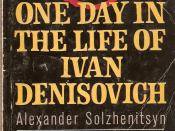Labor camps are horrifying places of murder, mistreatment and survival. The way accounts of this horror are delivered can create different, but equally terrifying pictures of what life was like for those who survived, and those who did not. In Alexander SolzhenitsynÃÂs fictional novel, One Day in the Life of Ivan Denisovich, Shukhov accepts the conditions in a Soviet labor camp and uses strategy formed with experience to survive his ten-year sentence. Bronia, an actual Polish survivor of the Nazi death camp, Auschwitz, tells her agonizing story of the brutality these camps concealed in a three page interview in Adam PhillipsÃÂ report ÃÂAn Auschwitz Survivor RemembersÃÂ. Though both stories are delivered in different context, character, mood, and thought, they convey the same image of the terrifying reality prisoners of these camps had to live everyday.
The way each story is written targets them at different types of audience reaction.
SolzhenitsynÃÂs novel is narrated in the third person central character and uses this technique to help the reader understand ShukhovÃÂs point of view on the value on his prison life. BroniaÃÂs interview is conducted in a third person manner, and uses emotional commentary to frame BroniaÃÂs story. This helps the reader understand the depth of turmoil she felt while she was trapped. Bronia, who was thrown into Auschwitz, tells her story through the eyes of an innocent twelve year-old-girl who was ripped away from her family and left to die. Shukhov, a fictional character, written by a man who was once enslaved, has been in the system for eight years and learned to live with the life that he had.
Sympathy is felt more for Bronia, who vividly remembers the barbaric acts she witnessed as a child and tells her story in her interview. The fact that she is...



Very interesting
Good read on a very important subject.
0 out of 0 people found this comment useful.